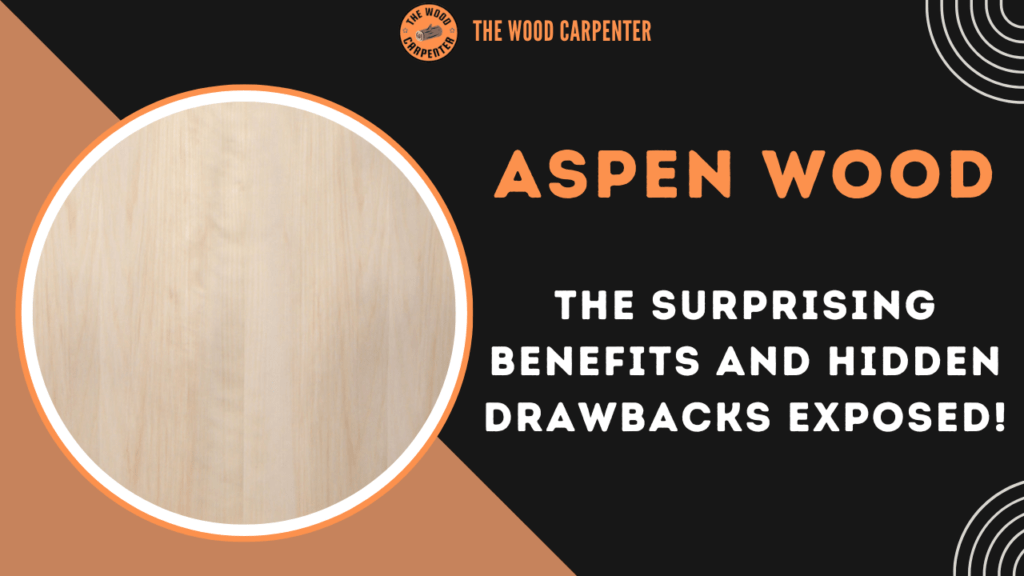
Aspen wood, sourced primarily from the quaking aspen (Populus tremuloides) and its close relatives, is a light, soft hardwood native to North America, Europe, and Asia. Often overlooked in favor of more robust hardwoods, aspen offers unique qualities that make it a valuable material for specific woodworking, industrial, and specialty applications.
This comprehensive guide covers aspen wood’s characteristics, uses, pros and cons, and answers common questions to help you determine if it’s the right choice for your next project.
Characteristics of Aspen Wood
Color and Appearance
Aspen wood is known for its light color, ranging from almost white to pale yellow or creamy. There’s little difference between the inner and outer parts of the wood, so the boards usually look even and bright. It has a fine, straight grain and a smooth surface, which makes it look nice and easy to finish.
Weight and Density
Aspen is a lightweight wood, weighing about 26 pounds per cubic foot. It’s not as dense as many other hardwoods, so it’s easy to carry, move, and work with, especially on large or detailed projects.
Hardness and Strength
Aspen is a soft hardwood, with a Janka hardness of 350 to 420 lbf. It’s not as strong or tough as oak or maple, but it still handles some impact well and stays stable without changing shape too much.
Workability
Aspen is easy to work with using tools. You can cut, carve, sand, and shape it without much trouble. That’s why it’s great for beginners or detailed wood projects. It glues well, takes paint and stain evenly, and doesn’t split easily when nailed.
One small downside: the surface can feel a little fuzzy after cutting, so it needs careful sanding to make it completely smooth.
Odor and Allergies
Aspen doesn’t have a strong smell and doesn’t produce resin, so it’s a good choice for clean environments like saunas or food storage areas. It’s also less likely to cause allergies compared to other woods.
Common Uses of Aspen Wood
Aspen’s properties lend themselves to a wide range of uses, particularly where light weight, smooth texture, and a clean appearance are desired.
Furniture and Cabinetry: Used for drawer sides, frames, and lightweight furniture pieces. Its uniform color and grain allow for a modern and a clean look.
Interior Millwork: Popular for moldings, doors, picture frames, and paneling, especially in contemporary spaces.
Crafts and Carving: Ideal for beginners and intricate work due to its softness and ease of shaping.
Veneer and Plywood: Frequently used in the core layers of plywood and as a veneer for paneling and matchsticks.
Paper and Pulp: A major source for pulpwood in the paper industry.
Specialty Items: Saunas, kitchen utensils, toys, animal bedding, and even chopsticks benefit from aspen’s non-resinous, non-toxic qualities.
Animal Bedding and Food Supplements: Aspen shavings are a popular, low-dust bedding for pets and research animals.
Fuel and Excelsior: Used for wood wool (excelsior), kindling, and as a fuel source, though it burns quickly and is best used when well-seasoned.
Also read:
Gidgee Wood: 7 Key Characteristics You Need to Know
Poplar Wood 101: Detailed Insights and Practical Uses for DIYers
Pros and Cons of Aspen Wood
| Pros | Cons |
| Lightweight and easy to handle | Low hardness; prone to dents and scratches |
| Smooth, straight grain; easy to machine and carve | Not durable for outdoor or high-traffic use |
| Uniform pale color; takes stain and paint well | Susceptible to moisture, rot, and insect attack |
| Non-resinous and low allergenic properties | Limited strength; not for heavy load-bearing applications |
| Affordable and widely available in North America | Requires regular sealing and maintenance |
| Good dimensional stability under changing temperatures | Often not available in thick stock |
| Resists splitting when nailed | Surface can be fuzzy after machining; needs fine sanding |
Durability and Maintenance
Aspen is best suited for indoor applications where it will not be exposed to moisture or heavy wear. Its softness and lack of natural rot or insect resistance mean it is not recommended for outdoor projects, structural uses, or high-traffic flooring. Regular sealing and careful maintenance are necessary to protect aspen wood from moisture, stains, and wear.
Aesthetic Appeal
Aspen’s pale, uniform color and smooth texture make it a favorite for modern and minimalist designs. It brightens interiors and provides a neutral palette for stains, paints, or clear finishes. Its subtle grain pattern supports detailed carving and decorative work, and it can be easily customized to fit a variety of styles.
Sustainability
Aspen is a abundant & fast-growing, making it a sustainable choice for many wood products. It is widely distributed across North America and is not listed as threatened or endangered.
Frequently Asked Questions (FAQ)
Is aspen wood a hardwood or a softwood?
Aspen is a hardwood, as it comes from a deciduous tree, but it is classified as a soft hardwood due to its low density and softness.
Is aspen wood good for furniture?
Aspen is suitable for lightweight, indoor furniture and cabinetry, especially where a smooth finish and light color are desired. However, it is not recommended for heavy-use or load-bearing furniture due to its softness.
Can aspen wood be used outdoors?
No, aspen is not naturally resistant to moisture, rot, or insects, making it unsuitable for outdoor use or environments with high humidity.
Does aspen wood require special maintenance?
Yes, aspen needs to be sealed regularly and handled carefully to keep it from getting dents, scratches, and water damage. Sanding surfaces smooth and using finishes that are right for the job will protect them.
Is aspen wood safe for toys and kitchenware?
Yes, aspen’s non-resinous and low-allergenic nature makes it safe for toys, utensils, and food storage items.
Why is aspen wood not used for structural lumber?
Aspen’s low hardness and strength make it unsuitable for structural or load-bearing applications. It is best reserved for decorative, utility, or specialty uses.
How does aspen compare to other hardwoods like oak or maple?
Aspen is much softer and lighter than oak or maple, making it easier to work with but less durable. It is more affordable and widely available, but not suitable for heavy-duty or outdoor applications.
Does aspen wood have any odor or toxicity?
Aspen is odorless and considered non-toxic, making it ideal for sensitive environments and those with allergies.
What is the best finish for aspen wood?
Aspen takes paint and stain well, but because of its softness, a protective clear finish or sealant is recommended to guard against wear and moisture.

